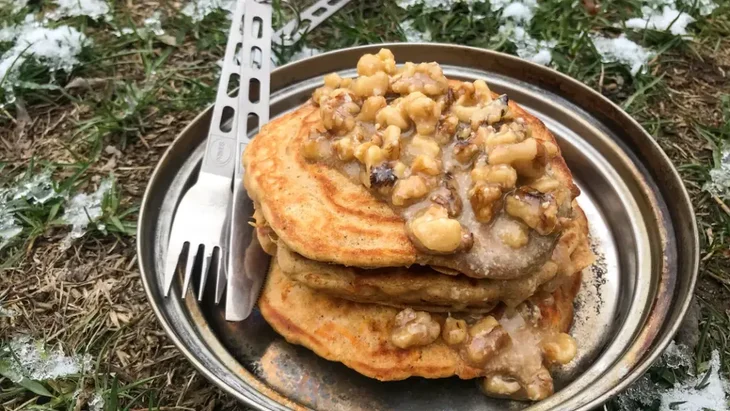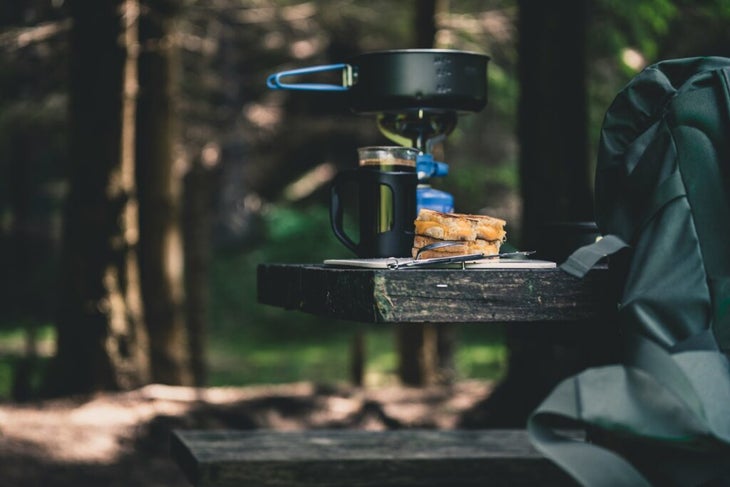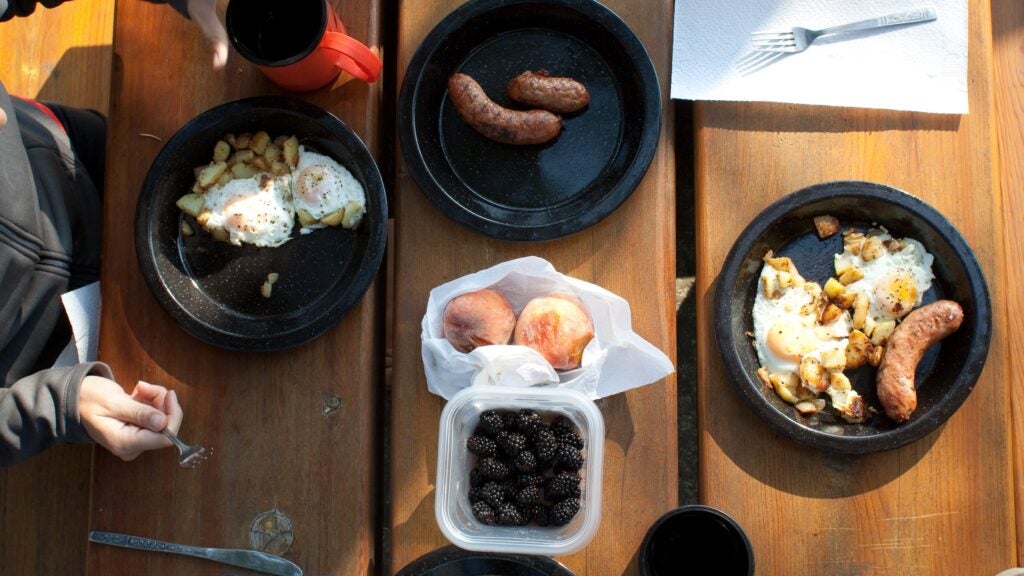No products in the cart.
Outdoor Adventure
How to Host Brunch in the Backcountry (Mimosas Included)
Heading out the door? Read this article on the Outside app available now on iOS devices for members!
Download the app.
Even if you hate getting out of bed, you have to admit that mornings are the best part of camping. Waking up slowly, rising with the sun, taking time to watch the world warm up over your first (and second) cup of coffee—there’s nothing quite like it. And as any fan of the slow morning knows, the best way to really draw out those golden hours is by extending breakfast as long as possible. In other words, turning it into brunch.
Brunch is an especially useful tool to have in your back pocket if you’re taking a first-timer on their first backpacking or camping trip. We’ve found that the best way to woo a partner, sway a dubious family member on the outdoors, or impress a group of friends is to wake up a little early and surprise them with an elaborate breakfast.
Want to do it right? Here are five ways to get the most out of your next camp morning and throw the best backcountry brunch of your life.
1. Set the scene

If you’ve ever been to a boozy brunch, baby shower, or other similarly festive mid-morning event, you know that presentation is half the battle. This is especially true if you’re trying to impress people. Lay out a tablecloth, pop up the camp chairs, and break out your best camping enamelware. If you want to dress up a little, go for it: An apron is always a nice touch.
2. Get the equipment
You don’t need special gear to throw a memorable brunch, but a few key tools can take things to the next level. If you’re car-camping, a foldable aluminum camp table and a few high-quality camp chairs can make a major difference in diner comfort. A Dutch oven will let you make cornbread, crustless quiche, and other delicacies; meanwhile a pie iron opens the door to hashbrown hand pies and grilled breakfast sandwiches.
If you’re backpacking, you’re more limited. However, cooking on a remote canister stove or white-gas stove can give you more control over cooking temperature—ideal for making pancakes and other low- to medium-heat baked goods. Also make sure you have the essentials: a good nonstick pan, plenty of fuel, utensils, a sharp knife, and a small cutting board.
3. Flip a flawless pancake

There are few people who don’t like waking up to a hot stack of pancakes. Unfortunately, there are also few people who can actually cook them in the backcountry without charring both sides and covering themselves in batter. The secret? This method:
- Use a thick, aluminum, nonstick pan. Titanium and other lightweight backpacking pans tend to heat unevenly, burning pancakes in the middle and leaving the edges raw. Don’t be afraid to pack in your real kitchen pan for a special occasion.
- Add oil such that it just barely covers the bottom of the pan.
- Turn up the stove to medium-low heat and wait for the oil to heat properly before you add batter. You’ll know it’s ready when the oil “shimmers,” or sparkles with little bubbles. Another good way to test heat is by flicking water at the pan off the tips of your fingers. If they sizzle and evaporate right away, you’re good to go.
- Add batter in small dollops with a spoon. Now, be patient. Flipping a pancake too soon can cause it to stick and break. You know they’re ready to flip when bubbles rise through the batter and burst, usually after two or three minutes.
- Flip and cook for an additional two or three minutes. Cover with a small towel to keep warm until your diners arise.
Practice at home first. Once you’ve mastered the technique, try these recipes:
4. Venture into French toast
Pancakes feeling a little too tried-and-true? French toast takes it up a notch. Try making stuffed French toast by sandwiching nutella, peanut butter, or jam between two slices of bread (we prefer day-old Challah bread). Or, serve up our classic backcountry recipe with fresh, sliced strawberries and whipped cream. Pro tip: If you don’t have a cooler on hand, opt for a can of coconut whipped topping, which lasts longer without refrigeration than your traditional dairy-based whip.
5. Cook over a campfire

If you’re camping in an area where fires are both permitted, you can really pull out all the stops. Campfire cooking adds rich, smoky flavor and crispness to everything from baked goods to bacon. (Plus, it also looks really impressive.) Some ideas:
- Wrap sausages, onions, peppers, and breakfast potatoes in foil packets and bake over hot coals.
- Cook bacon and eggs with the infamous paper-bag trick.
- Tuck chopped apples, butter, and cinnamon into a foil packet, bake in hot coals, then spoon over pancakes or oatmeal.
- Make these trail cinnamon rolls in a cast-iron skillet or in a covered Dutch oven.
6. Mix a mimosa
Orange juice isn’t shelf-stable—but you know what is? SunnyD. And Tang. We prefer the former, but you do you. Pick up a small bottle of SunnyD from the shelf-stable juices section of the grocery store and a can of champagne or sparkling white wine from your local liquor store (yep, wine comes in cans now). The best ratio is equal parts juice and bubbly. Pour into mugs and serve.
7. Brew a perfect cup of coffee

There are a dozen ways you could brew java, but if you’re trying to impress a cranky riser, cowboy coffee isn’t one of them. Elevate your morning joe by bringing fresh grounds in a zip-top bag or using a fancy grinder to prepare the beans in camp. The humble pourover is among the lowest-maintenance brew methods, but it can be hard to get right. We recommend a traditional French press for big groups and the highly easy-to-clean backpacker-friendly AeroPress Go for small ones.
Source link

